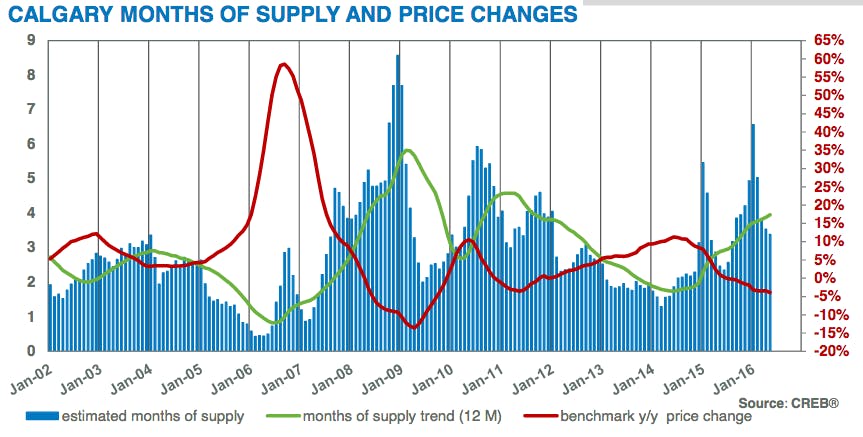market update report
Team Penley McNaughton YYC Newsletter and Market Statistics



Click on the following link to view the full Team Penley McNaughton’s YYC Newsletter for May 2016
Calgary 2015 December Market Update
Housing market characterized by slow demand
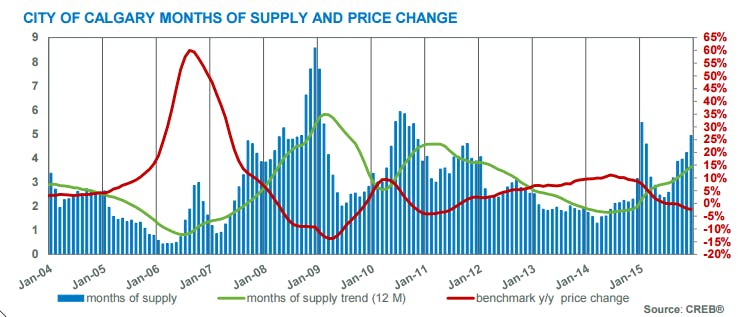 Elevated supply levels placed downward pressure on prices in December:
Elevated supply levels placed downward pressure on prices in December:
Calgary, Jan. 4, 2016 – With the focus shifting toward the holiday season, December sales activity slowed to 878 units in the city, 18 per cent below last year at this time and well below the five and 10-year averages.
As a result, the unadjusted benchmark price dipped to $448,800, a 0.42 per cent decline over the previous month and 2.33 year over year. CREB® chief economist Ann-Marie Lurie noted December followed a pattern established early on in 2015, which was characterized by slower housing demand.
“Economic uncertainty, followed by weak economic conditions and job losses, contributed to slowing housing demand throughout the year,” she said.
“That said, while aggregate prices trended down in 2015, it was not to the same extent as some had speculated. Supply levels were low moving into this cycle and thus provided some cushion to absorb the inventory gains.”
In December, monthly inventory levels declined, as expected, to 4,336 units. Yet they were still 28 per cent higher than the same time last year, and at the highest December level recorded since 2008. Inventory levels were notably up in both the apartment and attached sectors, which neared the highest December total on record.
“December showed that buyers in this market are continuing to be much more cautious as the impact of further oil price declines weighs on their confidence,” said CREB® president Corinne Lyall. “Some sellers, meanwhile, are concerned about what supply levels may look like next year and are not delaying their decisions.”
On an annual basis, sales activity declined by 24 per cent in the detached sector and 33 and 28 per cent in the apartment and attached segments, respectively. While months of supply in 2015 trended higher in all sectors, the apartment was the only one to average above four for the entire year.
Click here to view the full monthly stats package.
Housing prices to ease in second half, CREB® forecasts
Continued weakness in housing demand will limit downward pressure on supply levels and cause prices to ease in the second half of the year, CREB® said in its 2015 mid-year forecast. Despite this anticipated retraction, Calgary’s benchmark prices are only expected to decline by less than one per cent on an annual basis.
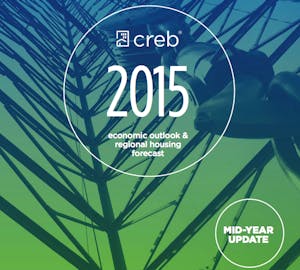
“Further job losses are expected in the second half of the year,” said CREB® chief economist Ann-Marie Lurie. “These employment changes, combined with overall weakness and slower than anticipated recovery of oil prices, are expected to keep housing demand relatively weak for the rest of 2015. However, with the initial shock of oil price declines having dissipated, the pullback in sales activity in the second quarter is not expected to be as dramatic as the first part of the year,” said Lurie.
Overall sales activity in Calgary is forecasted to total 19,798 in 2015, a 22 per cent decline relative to last year, but only six per cent lower than average activity over the past five years.
Dramatic swings in new listings during the first half of the year caused inventory levels to rise, but by June, they remained below previous highs. Over the second half of the year, inventory levels traditionally ease as we move toward the fall and winter markets. However, this year housing supply levels are expected to remain relatively elevated due to improved selection in the rental markets, completion of projects under construction, and an easing in the rate of decline in resale new listings.
While some price moderation is expected moving forward, it should be noted that it’s not going to be the double-digit decline that some have suggested. In part, this is related to the limited supply in the market moving into this next cycle. Also, the forecasted pullback in employment and migration is not going to be as severe as what occurred last time we recorded significant price declines. The City of Calgary residential benchmark price is expected to average $448,354 for 2015, a modest 0.20 per cent decline over the previous year.
“It’s a two sided coin when talking about pricing for buyers and sellers,” said CREB® president Corinne Lyall. “Some buyers have the expectation that they will get significant price reductions in this market, but that’s not always the case. In some areas, supply levels are more balanced with demand and that creates price stability. On the other hand, in most situations, it will be the sellers who need to adjust expectations, particularly if they have to compete with a large amount of comparable product in the neighbourhood.”
While slower demand is impacting all sectors of the market, the apartment sector is expected to record the largest pull-back in both sales and price growth in the second half. Challenges in this segment are linked to the rising supply in competing markets. There is more selection is the detached and attached segments, which makes it difficult to attract buyers. Sellers also faced added competition from new apartment units and increased selection in the rental market.
Meanwhile, activity in the detached segments will continue to vary based on price and location. Continued weakness in demand relative to supply levels, particularly in the higher price ranges, are expected to cause aggregate detached benchmark home prices to decline in the second half of this year. However, annual prices are expected to remain relatively unchanged compared to last year. Overall, detached sales are expected to total 12,105 units in 2015, a 19.8 per cent decline over last year.
“It’s important for active housing consumers to understand what type of comparable property is available by product type, community and price range,” said Lyall. “While some degree of competition exists in every market condition, most sellers in the current environment will need to take extra care in setting realistic expectations to attract a good crop of potential buyers. This kind of smart pricing may encourage buyers who are sitting on the sidelines to consider entering the market if they are in a position to do so.”
As with any market forecast, there are several factors that could influence the outlook. On the upside, if there is no further deterioration in the economic climate, it’s possible that the pullback in housing demand could be less severe. In this scenario, potential buyers who are in the market may decide to take advantage of higher supply levels and overlook short-term risks in favour of the positive long-term outlook. This possibility could keep market conditions relatively balanced in the second half and prevent any further price declines.
“Ultimately, what happens to prices will depend on supply levels and how much they go up or down against demand,” said Lurie. “The duration of this economic downturn and the resulting job loss will determine which direction supply will go in the months ahead.”
To download a PDF of the full CREB® mid-year forecast update, click here
Market Trends: Farm Edition 2013
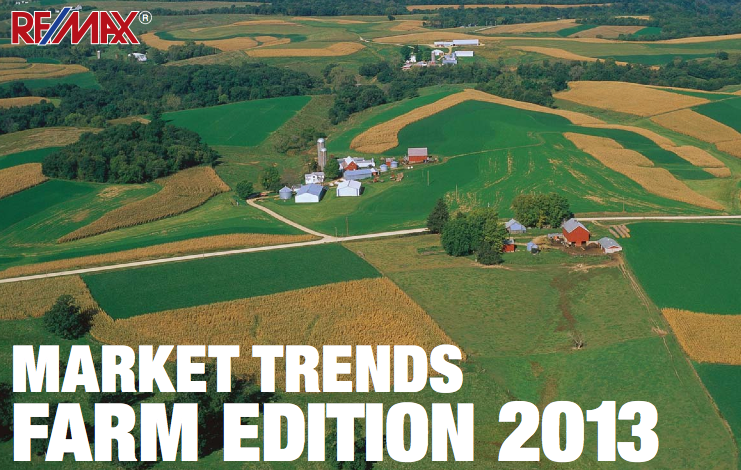 Click here on the image above to view the full report: Canada wide!
Click here on the image above to view the full report: Canada wide!
Central Alberta
Southern Alberta
CALGARY REGIONAL HOUSING MARKET STATISTICS for August 2013
SUMMER SALES STAY STRONG
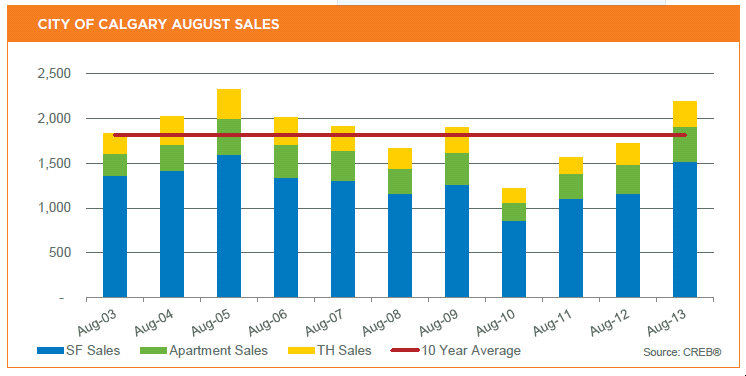
Seller’s market conditions persist, pushing up prices
(click on the photo above to download the full report)
Residential sales within city limits totaled 2,196 units, an 27.5 per cent increase over 2012 and 8.7 per cent on a year-to-date basis.
The level of transactions was well above long-term trends for the month, mostly due to improved activity in the single-family sector. However, on a year-to-date basis, activity is only slightly higher than expectations.
“The sales have been limited by the need for more resale listings,” said CREB® President Becky Walters. “However, August did see more new listings than last year, giving buyers more choice.”
August new listings recorded a year-over-year improvement of 7.4 per cent. While seller’s market conditions persist and total inventory levels keep falling, improvement in new listings helped prevent further tightening in the market despite the sales growth.
Single-family sales totaled 1,517 units in August, a 30 per cent increase over the previous year. Despite strong sales in the past couple of months, year-to-date sales activity has grown by 5.4 per cent, slightly stronger than anticipated.
Click on the following link to download the full report of the Monthly Housing Statistics for August.
City's housing affordability 'among better in Canada'
Calgary’s housing market appears to have weathered the worst floods in memory with the second-strongest quarterly sales gain in four years, says the Royal Bank.
“A strong provincial economy, solid labour market, fast-rising population, and attractive affordability continue to fuel demand for Calgary housing,” said the bank’s latest Housing Trends and Affordability Report, to be released Tuesday.
The RBC report, which measured the April to June period, said monthly resale activity increased for six straight months, including in June (rising 1.1 per cent month-overmonth) and July (up 3.1 per cent). On a quarterly basis, home resales rose 12 per cent.
“While prices recently embarked on a more steeply upward trajectory, the effect of faster-rising prices has yet to undermine affordability in any material way,” said RBC. “In fact, affordability levels in Calgary continue to be among the better in Canada.”
The RBC affordability index determines the proportion of median pretax household income needed to service the cost of mortgage payments, property taxes and utilities.
Its measures for Calgary showed little movement in the second quarter, with two-storey homes rising by 0.5 percentage points to 33.6 per cent, while condominium apartments edged lower by 0.2 percentage points to 19.4 per cent.
And while the report cautions home ownership has become less affordable for the average Canadian, RBC said Alberta homebuyers continued to enjoy a relatively affordable housing market.
“Despite the fact that the market has kicked into higher gear since spring – thereby boosting prices and increasing ownership costs – Alberta continues to be a relatively affordable market,” said Craig Wright, senior vice-president and chief economist with RBC. “We will likely see some disruptions in market activity trickle through in summer data from the floods in southern Alberta; however, we anticipate the strong provincial economy will endure, supporting further housing growth in 2014.”
Nationally, during the second quarter, affordability measures rose for two of the three categories of homes tracked. RBC’s measure for the detached bungalow rose 0.3 percentage points and for the standard two-storey home rose 0.4 percentage points to 42.7 per cent and 48.4 per cent, respectively. The measure for the standard condominium was unchanged at 27.9 per cent.
Vancouver’s affordability measure gained 2.2 points to 82.1 on a detached bungalow, while Toronto’s increased half a point to 54.5.
CALGARY REGIONAL HOUSING MARKET STATISTICS
CALGARY RESALE MARKET REACHING NORMAL
2012 saw end to four years of weaker sales activity
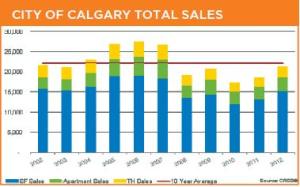
Click on the picture above to download a full version of this report.
Calgary, Jan. 2, 2013 – Residential real estate sales in the city of Calgary ended the year on a high note, with sales volume up 15 per cent in 2012 compared to 2011, and benchmark prices up five per cent.
“Calgary’s housing market has finally started to recover,” said Ann-Marie Lurie, CREB®’s chief economist. “While prices remain shy of the highs recorded in 2007, this is a move in the right direction.”
Much of the sustainable recovery is fueled from the growth in the energy sector, spilling over into all aspects of our economy, including housing, said Lurie. “There is no question employment and migration growth has supported housing demand, a trend that is expected to continue this year, albeit at a slower pace.”
The single family market sales growth outpaced increases in the total condominium market within city limits. Single family sales rose by 15 per cent in 2012 compared to 2011. New listings did not keep pace, declining by seven per cent over the same period. This has significantly reduced the inventory of single family homes in the market, pushing prices up.
“Consumers in the market were looking for value and, if a home was priced right based on a longer term view of their housing needs, they were buying,” said 2012 CREB® President Bob Jablonski.
The price spread is expected to narrow as balanced market conditions support further price growth, he said. But in most communities, prices remain lower than 2007 levels.
The unadjusted single family benchmark price was $434,800 for the month of December, 8.7-per-cent higher than 2011. On average, single family prices are up by seven per cent for the year, and remain two per cent below peak pricing in 2007.
Condominium sales are improving, as lower supply levels and rising prices in the single family market drove consumers to explore alternatives. Sales in the apartment and townhouse sector recorded annual increases of 12 and 16 per cent, respectively. Meanwhile, listings are declining in both sectors, keeping both markets in balanced conditions. Price growth has not been at the same pace as what was recorded in the single family sector.
Condominium apartment benchmark prices totaled 248,700 in December, a 5.4 per cent increase over 2011. Annual average benchmark increases were two per cent, significantly lower than the five per cent increase in the annual average price.
Click on the following link to download a full version of the CALGARY REGIONAL HOUSING MARKET STATISTICS Report.






